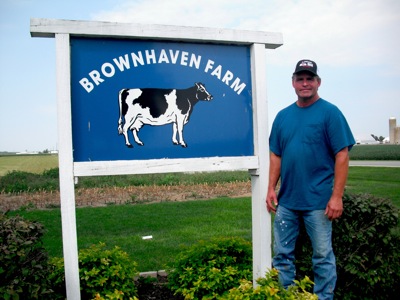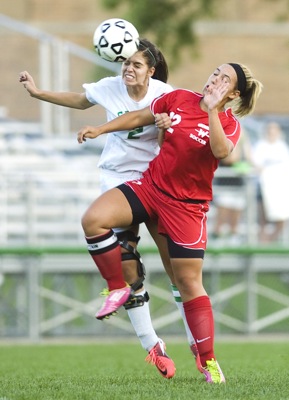Tuesday, September 13th, 2011
Farms lauded for conservation work
Dairy, poultry farm are doing things right, agriculture organizations say
By Nancy Allen

Photo by Nancy Allen/The Daily Standard
Lou Brown stands next to the sign at his family's dairy outside New Bremen. The dairy received this year's Dairy Environmental Stewardship Award. The Dahlinghaus Farm, also near New Bremen, received the Poultry Environmental Stewardship Award.
Perhaps no farmers receive more scrutiny about how they manage their manure than those in the Grand Lake Watershed.
Two such farmers in Auglaize County were honored recently for their conservation practices.
Brownhaven Dairy received this year's Dairy Environmental Stewardship Award, and the Dahlinghaus Farm received the Poultry Environmental Stewardship Award. Both farms are in New Bremen.
Brownhaven Dairy on state Route 364, owned by Lou and Alan Brown, includes 230 acres. A 160-head heifer facility is located a mile north of the dairy. The farm grows corn, alfalfa and orchard grass for feed, as well as wheat and 135 acres of cover crops.
"I live on a state highway, my buildings are close to the road and people are always looking at our operation to see what we are doing," Lou Brown said.
Many of the farm's conservation practices have been installed through the USDA's Environmental Quality Incentives program. The program provides financial and technical assistance to help farmers plan and install practices and in some cases take farmland out of production for plantings that help the environment.
The dairy's soil has been tested since the 1970s to keep nutrients at acceptable levels for crop production and the environment. A comprehensive nutrient management (CNMP) plan has been in place for five years.
The farm has 34 acres of hayland buffers along its fields, road ditches and creeks and two acres of quail buffers - a combination of native grasses and wildflowers planted on lower-yielding land along woods. The area prevents nutrient runoff while providing wildlife habitat.
"We do not have any problems with any high (phosphorous) levels because we've been managing them for the last 30 years," Lou Brown said.
The Browns have an agreement to spread the farm's manure on 300 acres owned by neighbors, who raise straw, hay and soybeans for the dairy.
The Browns installed a wetland four years ago in a natural low area between two woods that continually had damaged crops. The wetland diverts excess water from fields and prevents nutrient runoff. Their property also includes 25 acres of woods.
In the last four years, the Browns installed stops that can be opened and closed on the four tiles that leave the farm. Lou Brown said he shuts them completely when he applies manure and after crops are planted to keep water in the soil and improve yields.
Brown said local people and those outside the area are always impressed with the conservation on the farm.
"A lot are from out of state and out of the country and they're dealing with the same issues," he said. "This isn't the only place that has problems."
David White, director of the Ohio Livestock Coalition, said Brown's nomination application for the award stood out.
"When we looked at it, he's doing all the right things not only as a farmer in the lake watershed, but as a farmer in the state to protect natural resources and the environment," White said. "There are a lot of farmers doing things right, but Lou just happened to do it a little bit better."
The Paul and Donna Dahlinghaus farm on St. Johns Road has 600 acres. They raise turkeys for Cooper Farms, contract hogs for Kleinheinz Bros. Livestock Inc. and have about 65 cows.
On receiving the award, Dahlinghaus said, "we just try to do things right."
They work closely with soil and water conservation district officials and have a comprehensive nutrient management plan that covers manure and wastewater storage and handling issues, land treatment practices, feed management and more. Soil testing, to determine what nutrients are needed where, also is a component.
The farm has installed waterways and filter strips; streams and wells also are monitored regularly.
The farm has a dairy wastewater treatment system to safeguard against spillage or contamination and composts its own livestock losses.
Paul Dahlinghaus said he has planted cover crops for the past several years and put up two drystack manure buildings in recent years, one for turkeys and one for cows.
The awards are sponsored by the Ohio Livestock Coalition, Ohio Dairy Producers Association and Ohio Poultry Association.



